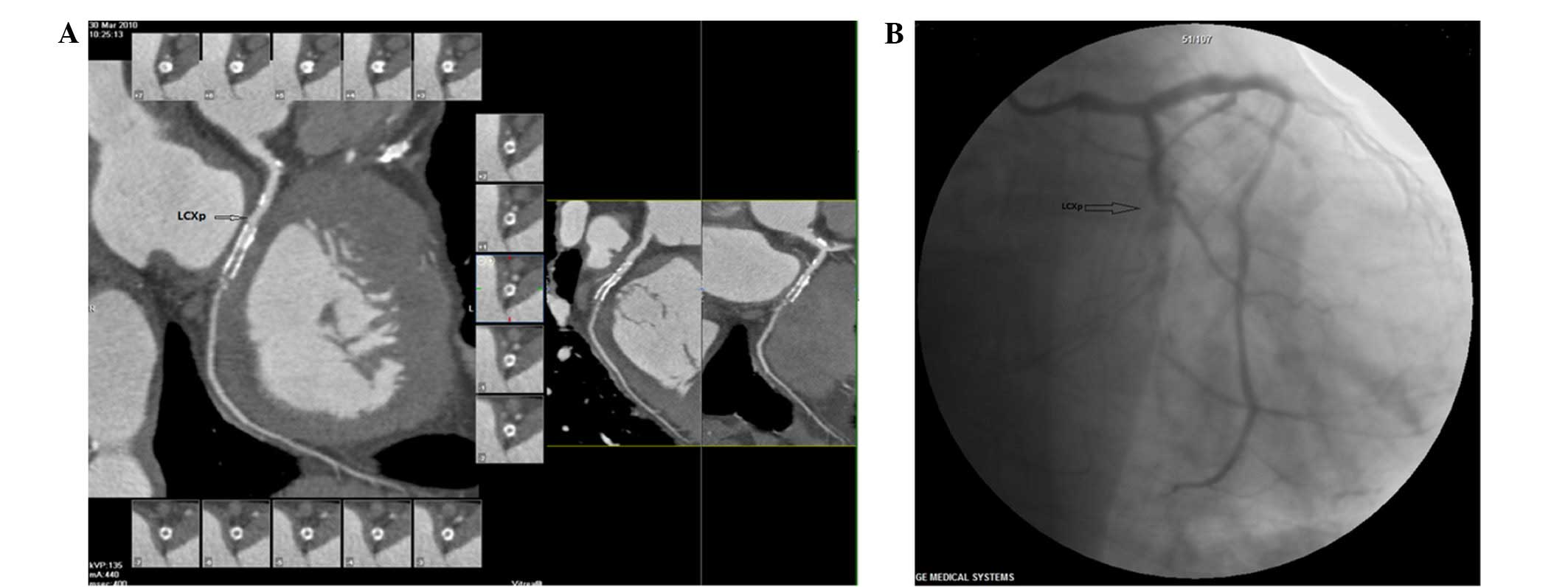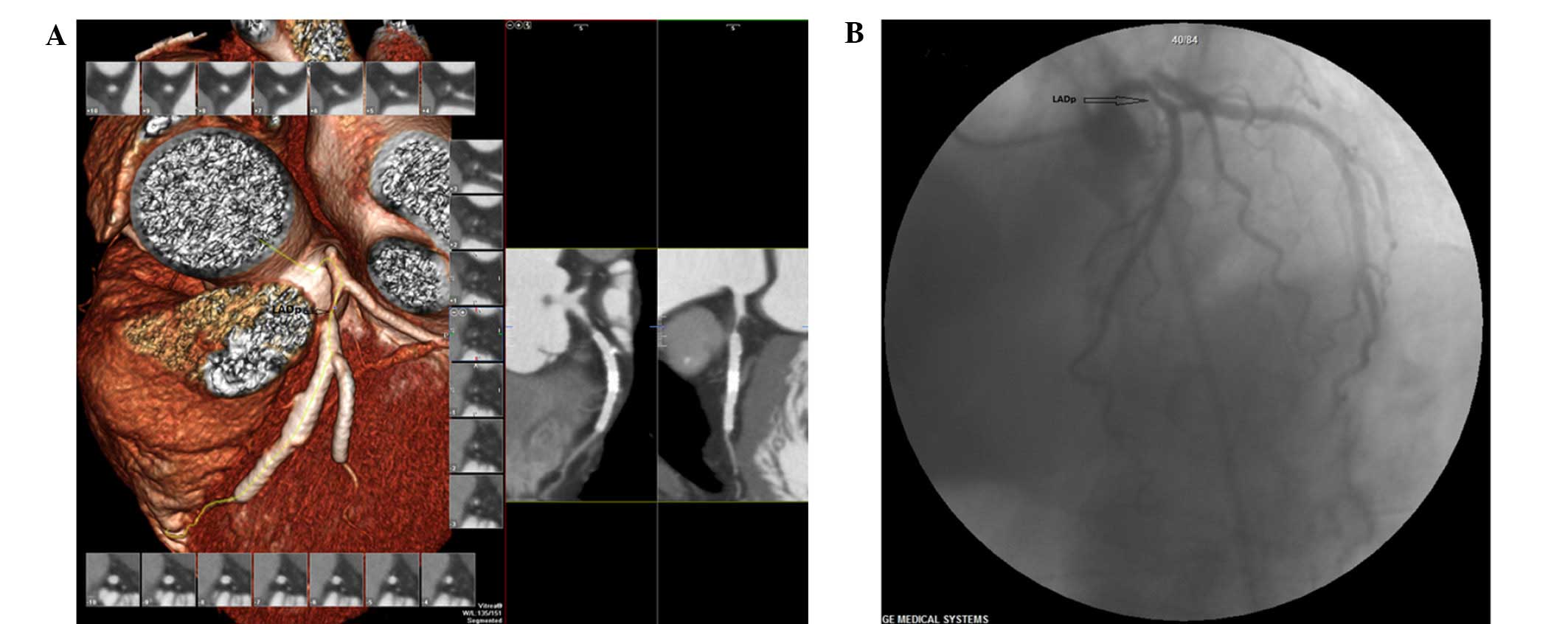|
1
|
Ehara M, Kawai M, Surmely JF, Matsubara T,
Terashima M, Tsuchikane E, Kinoshita Y, Ito T, Takeda Y, Nasu K, et
al: Diagnostic accuracy of coronary in-stent restenosis using
64-slice computed tomography: Comparison with invasive coronary
angiography. J Am Coll Cardiol. 49:951–959. 2007. View Article : Google Scholar : PubMed/NCBI
|
|
2
|
Chung SH, Kim YJ, Hur J, Lee HJ, Choe KO,
Kim TH and Choi BW: Evaluation of coronary artery in-stent
restenosis by 64-section computed tomography: Factors affecting
assessment and accurate diagnosis. J Thorac Imaging. 25:57–63.
2010. View Article : Google Scholar : PubMed/NCBI
|
|
3
|
Hong C, Chrysant GS, Woodard PK and Bae
KT: Coronary artery stent patency assessed with in-stent contrast
enhancement measured at multi-detector row CT angiography: Initial
experience. Radiology. 233:286–291. 2004. View Article : Google Scholar : PubMed/NCBI
|
|
4
|
Gaspar T, Halon DA, Lewis BS, Adawi S,
Schliamser JE, Rubinshtein R, Flugelman MY and Peled N: Diagnosis
of coronary in-stent restenosis with multidetector row spiral
computed tomography. J Am Coll Cardiol. 46:1573–1579. 2005.
View Article : Google Scholar : PubMed/NCBI
|
|
5
|
Gilard M, Cornily JC, Pennec PY, Le Gal G,
Nonent M, Mansourati J, Blanc JJ and Boschat J: Assessment of
coronary artery stents by 16 slice computed tomography. Heart.
92:58–61. 2006. View Article : Google Scholar : PubMed/NCBI
|
|
6
|
Ehara M, Surmely JF, Kawai M, Katoh O,
Matsubara T, Terashima M, Tsuchikane E, Kinoshita Y, Suzuki T, Ito
T, et al: Diagnostic accuracy of 64-slice computed tomography for
detecting angiographically significant coronary artery stenosis in
an unselected consecutive patient population: Comparison with
conventional invasive angiography. Circ J. 70:564–571. 2006.
View Article : Google Scholar : PubMed/NCBI
|
|
7
|
Seifarth H, Ozgün M, Raupach R, Flohr T,
Heindel W, Fischbach R and Maintz D: 64-Versus 16-slice CT
angiography for coronary artery stent assessment: In vitro
experience. Invest Radiol. 41:22–27. 2006. View Article : Google Scholar : PubMed/NCBI
|
|
8
|
Rist C, von Ziegler F, Nikolaou K, Kirchin
MA, Wintersperger BJ, Johnson TR, Knez A, Leber AW, Reiser MF and
Becker CR: Assessment of coronary artery stent patency and
restenosis using 64-slice computed tomography. Acad Radiol.
13:1465–1473. 2006. View Article : Google Scholar : PubMed/NCBI
|
|
9
|
Rixe J, Achenbach S, Ropers D, Baum U,
Kuettner A, Ropers U, Bautz W, Daniel WG and Anders K: Assessment
of coronary artery stent restenosis by 64-slice multi-detector
computed tomography. Eur Heart J. 27:2567–2572. 2006. View Article : Google Scholar : PubMed/NCBI
|
|
10
|
Oncel D, Oncel G and Karaca M: Coronary
stent patency and in-stent restenosis: Determination with
64-section multidetector CT coronary angiography-initial
experience. Radiology. 242:403–409. 2007. View Article : Google Scholar : PubMed/NCBI
|
|
11
|
Carrabba N, Bamoshmoosh M, Carusi LM,
Parodi G, Valenti R, Migliorini A, Fanfani F and Antoniucci D:
Usefulness of 64-slice multidetector computed tomography for
detecting drug eluting in-stent restenosis. Am J Cardiol.
100:1754–1758. 2007. View Article : Google Scholar : PubMed/NCBI
|
|
12
|
Das KM, El-Menyar AA, Salam AM, Singh R,
Dabdoob WA, Albinali HA and Al Suwaidi J: Contrast-enhanced
64-section coronary multidetector CT angiography versus
conventional coronary angiography for stent assessment. Radiology.
245:424–432. 2007. View Article : Google Scholar : PubMed/NCBI
|
|
13
|
Schuijf JD, Pundziute G, Jukema JW, Lamb
HJ, Tuinenburg JC, van der Hoeven BL, de Roos A, Reiber JH, van der
Wall EE, Schalij MJ and Bax JJ: Evaluation of patients with
previous coronary stent implantation with 64-section CT. Radiology.
245:416–423. 2007. View Article : Google Scholar : PubMed/NCBI
|
|
14
|
Tedeschi C, Ratti G, De Rosa R, Sacco M,
Borrelli F, Tammaro P, Covino G, Montemarano E, Cademartiri F,
Runza G, et al: Usefulness of multislice computed tomography to
assess patency of coronary artery stents versus conventional
coronary angiography. J Cardiovasc Med (Hagerstown). 9:485–492.
2008. View Article : Google Scholar : PubMed/NCBI
|
|
15
|
Hein PA, May J, Rogalla P, Butler C, Hamm
B and Lembcke A: Feasibility of contrast material volume reduction
in coronary artery imaging using 320-slice volume CT. Eur Radiol.
20:1337–1343. 2010. View Article : Google Scholar : PubMed/NCBI
|
|
16
|
de Graaf FR, Schuijf JD, van Velzen JE,
Kroft LJ, de Roos A, Reiber JH, Boersma E, Schalij MJ, Spanó F,
Jukema JW, et al: Diagnostic accuracy of 320-row multidetector
computed tomography coronary angiography in the non-invasive
evaluation of significant coronary artery disease. Eur Heart J.
31:1908–1915. 2010. View Article : Google Scholar : PubMed/NCBI
|
|
17
|
Dewey M, Zimmermann E, Deissenrieder F,
Laule M, Dübel HP, Schlattmann P, Knebel F, Rutsch W and Hamm B:
Noninvasive coronary angiography by 320-row computed tomography
with lower radiation exposure and maintained diagnostic accuracy:
Comparison of results with cardiac catheterization in a
head-to-head pilot investigation. Circulation. 120:867–875. 2009.
View Article : Google Scholar : PubMed/NCBI
|
|
18
|
de Graaf FR, Schuijf JD, van Velzen JE,
Boogers MJ, Kroft LJ, de Roos A, Reiber JH, Sieders A, Spanó F,
Jukema JW, et al: Diagnostic accuracy of 320-row multidetector
computed tomography coronary angiography to noninvasively assess
in-stent restenosis. Invest Radiol. 45:331–340. 2010.PubMed/NCBI
|
|
19
|
Desbiolles L, Leschka S, Plass A, Scheffel
H, Husmann L, Gaemperli O, Garzoli E, Marincek B, Kaufmann PA and
Alkadhi H: Evaluation of temporal windows for coronary artery
bypass graft imaging with 64-slice CT. Eur Radiol. 17:2819–2828.
2007. View Article : Google Scholar : PubMed/NCBI
|
|
20
|
Raff GL, Abidov A, Achenbach S, Berman DS,
Boxt LM, Budoff MJ, Cheng V, DeFrance T, Hellinger JC and Karlsberg
RP: Society of Cardiovascular Computed Tomography: SCCT guidelines
for the interpretation and reporting of coronary computed
tomographic angiography. J Cardiovasc Comput Tomogr. 3:122–136.
2009. View Article : Google Scholar : PubMed/NCBI
|
|
21
|
Schmitt F, Grosu D, Mohr C, Purdy D, Salem
K, Scott KT and Stoeckel B: 3 Tesla MRI: Successful results with
higher field strengths. Radiologe. 44:31–47. 2004.PubMed/NCBI
|
|
22
|
Peng LJ and Tian GP: Inflammatory reaction
and stent restenosis after coronary stent implantation. Shi Yong
Xin Nao Fei Xue Guan Bing Za Zhi. 14:13–15. 2006.(In Chinese).
|
|
23
|
Kitagawa T, Fujii T, Tomohiro Y, Maeda K,
Kobayashi M, Kunita E and Sekiguchi Y: Noninvasive assessment of
coronary stents in patients by 16-slice computed tomography. Int J
Cardiol. 109:188–194. 2006. View Article : Google Scholar : PubMed/NCBI
|
|
24
|
Zhu H, Warner JJ, Gehrig TR and Friedman
MH: Comparison of coronary artery dynamics pre- and post-stenting.
J Biomech. 36:689–697. 2003. View Article : Google Scholar : PubMed/NCBI
|
|
25
|
Şatiroğlu Ö, Bostan M and Bozkur E: Acute
coronary syndrome due to bare metal stent fracture in the right
coronary artery. Kardiol Pol. 69:859–861. 2011.PubMed/NCBI
|
|
26
|
Bilen E, Yasar Saatci A, Bilge M, Karakas
F, Kırbas O and Ipek G: Acute coronary syndrome due to complete
bare metal stent fracture in the right coronary artery. Int J
Cardiol. 139:e44–e46. 2010. View Article : Google Scholar : PubMed/NCBI
|
|
27
|
Kang WC, Han SH, Ahn TH and Shin EK: Acute
myocardial infarction caused by rupture of minimal intrastent
intimal hyperplasia after implantation of bare-metal stent. Int J
Cardiol. 120:e37–e40. 2007. View Article : Google Scholar : PubMed/NCBI
|
|
28
|
Giuliani G, Maehara A and Parodi G: Vessel
response evaluation by optical coherence tomography after
drug-eluting stent implantation in the left main coronary artery. G
Ital Cardiol (Rome). 11:2462010.(In Italian). PubMed/NCBI
|
|
29
|
Ruygrok PN, Webster MW, Ardill JJ, Chan
CC, Mak KH, Meredith IT, Stewart JT, Ormiston JA and Price S:
Vessel caliber and restenosis: A prospective clinical and
angiographic study of NIR stent deployment in small and large
coronary arteries in the same patient. Catheter Cardiovasc Interv.
59:165–171. 2003. View Article : Google Scholar : PubMed/NCBI
|
|
30
|
Sousa JE, Costa MA, Sousa AG, Abizaid AC,
Seixas AC, Abizaid AS, Feres F, Mattos LA, Falotico R, Jaeger J, et
al: Two-year angiographic and intravascular ultrasound follow-up
after implantation of sirolimus-eluting stents in human coronary
arteries. Circulation. 107:381–383. 2003. View Article : Google Scholar : PubMed/NCBI
|
|
31
|
Ahmed JM: Serial intravascular ultrasound
assessment of the efficacy of intracoronary gamma radiation for
preventing recurrent in-stent restenosis. Minerva Cardioangiol.
50:507–515. 2002.PubMed/NCBI
|
















